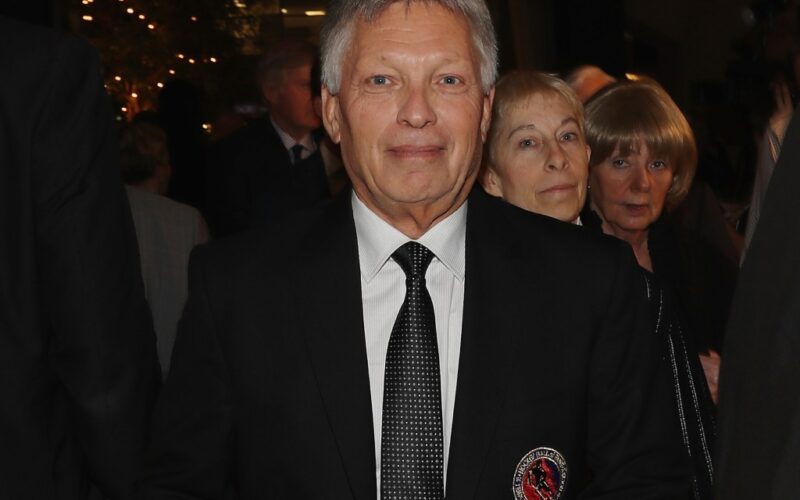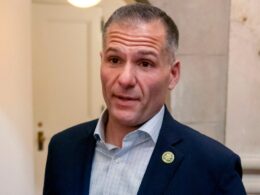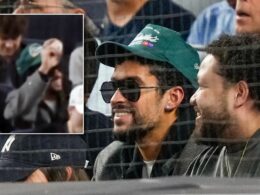Larry Brooks didn’t need to go to a Florida Panthers off-day practice. Neither did I.
But there we were on Friday, Nov. 20, 2015, the legendary New York Post hockey columnist and I, the Daily News’ Rangers beat writer, standing together in the locker room of the ‘Puddy Tats’ — as Larry used to call them — in Sunrise, Fla.
Waiting.
Until that deep voice with an unmistakable accent bellowed.
“LAH-dee!”
And Jaromir Jagr — ‘The Great Jagr’ or ‘Yahgs,’ as Larry called him — strode out from a back room in a black T-shirt and jeans.
Jagr, an all-time great still playing at age 43, answered to no one. He had walked into that room for one reason only: because Larry was in it.
So Larry easily could have — should have — used that relationship and access to conduct one of his famous one-on-one interviews and craft an exclusive story for Saturday’s Post.
The News and the Post are archrivals, after all. Always have been. Always will be.
But that’s not what Larry did.
Instead, Larry introduced me to Jagr, told him he could trust me and welcomed me into a 10-minute conversation that was part interview, part catch-up with a legend of the game.
The News had a story on Jagr in the next day’s paper, just like the Post.
And I walked outside into the Florida sunshine knowing that I didn’t just cover the legends of hockey; I worked alongside one of them.
‘Brooksie,’ as he was known in rinks across North America, who had dubbed Henrik Lundqvist ‘The King’ as a young Ranger, was a king himself.
He was the first person I ever heard refer to Wayne Gretzky as “Wayne.”
Lundqvist looked upon Larry during their many conversations not as an inquiring reporter but as a revered peer, as if the goalie were prepared to learn as much from Brooksie as Larry would from him.
But Larry was even more than a Hockey Hall of Famer, inducted in 2018.
What made him great to me was his part in our unique friendship, our human connection that crossed the boundaries of New York’s ‘tabloid wars,’ his ability to kick my butt as competitors during the day and then share his life and lessons with me over a glass of wine at night.
Former Rangers coach John Tortorella said Thursday that he respected how Larry always showed up every day, ready to answer to what he’d written the day before and ready to keep working on the next story.
In other words, Larry cared.
And that is what people should know about what made Larry great as a person and a professional: He cared. Deeply.
About hockey. About quality of work. And about the people who mattered to him.
That is a contagious quality, caring. It showed up with Brooksie in a lot of different ways.
Right up until he passed Thursday at age 75 after a battle with cancer, Larry’s favorite inside joke with me was a reference to a scene out of the Rangers’ 2011-12 locker room.
It was my first season covering the NHL, and Rangers forward Ruslan Fedotenko was trying to explain to me that the team had allowed one goal because they didn’t have a “third man high” in the offensive zone.
I grew up primarily studying the X’s and O’s of basketball, not hockey. So when I asked Fedotenko to elaborate, the winger could see my confusion and yelled out in high-pitched disbelief: “You don’t see?!”
It was a favorite memory of ours because it revealed how green I was as a rookie on the beat and, frankly, because it made Larry laugh hysterically every time we brought it back up.
At a different point in Larry’s career, he had been much more ruthless and relentless in his competition with rival papers. But when I arrived — and when I proved that I cared, too — he embraced me as an unexpected and willing mentor.
For five NHL seasons, we saw each other more than we saw our own families. We shared a birthday on Feb. 26. We hopped back and forth between Marriotts across the continent in an unforgettably close travel contingent that included the Bergen Record’s Andrew Gross, ESPN’s Katie Strang, Newsday’s Steve Zipay and the Post’s Brett Cyrgalis.
And what that meant was that I had the privilege of sitting across from Larry at dinner two to three times a week and listening.
He would talk about his reverence for Mike Bossy and the Islanders dynasty, his unique experiences with Devils greats Martin Brodeur and Scott Stevens, his strong friendship with former Rangers agitator Sean Avery and his affinity for covering baseball a bit every offseason. He said he liked writing about America’s Game because it required “a different rhythm” from the writer’s mind and hand.
But he would really light up describing his grandson Scott’s early passion for hockey, his granddaughter Reese and the thrill of having them in his life.
During one of those memorable meals, at our go-to spot Vallozzi’s in Pittsburgh, we unexpectedly veered off those topics because Hall of Fame baseball manager Jim Leyland and his wife were seated at the table next to us.
And there I was again, not just watching a conversation between two legends but having one with them.
Because Larry was there.
I am proud to say that, in my opinion at least, I did my best to learn from Larry and to let him know how much I respected and appreciated him.
He spoke truth to power and worked to hold people or organizations accountable when they deserved it, especially the NHL in his iconic weekly ‘Slapshots’ column.
He was not only willing but eager to be the only voice on one side of an issue if he knew he was right. Even if the noise around him was loud.
He showed up every day, especially after he had written something critical or scathing, to answer to the fallout or the blowback.
He spoke for the players. He worked hard at reporting so that any column or opinion was backed by information.
He didn’t use a recorder or a camera on his phone to tape interviews. He talked to people face to face like human beings.
He had fun with his prose, like his playful “Did you see Chris?” line about Rangers goalscorer Chris Kreider’s dual ability to both flash and dim.
He did his own work. He thought for himself.
And Larry’s presence and influence were so consistent, he gave every empty rink he walked into a heartbeat.
When they build a statue of him somewhere inside Madison Square Garden one day, they should memorialize Larry in his trademark pose:
Sitting beside a player at his locker with his head down, taking notes in shorthand into his notebook with a slight smirk.
The smirk because Larry loved what he was doing and probably knew something everyone else didn’t.
The notetaking because of how deeply Larry always stayed grounded in the work.
The close proximity to the player because of how much Larry cared about the person next to him.
So much so that he was willing to cross the Post-Daily News battle lines to take a young reporter under his wing.
“You don’t see?!”
We see, Larry. We all see.
Rest in peace to The Great One. The Great Brooksie. The King.








